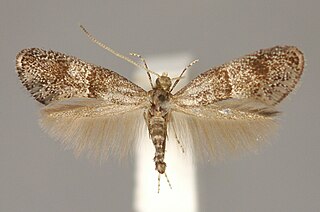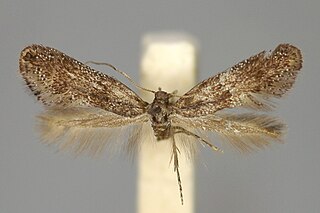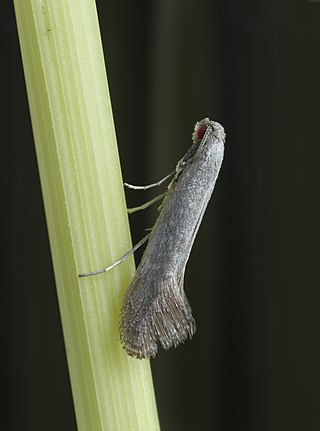
Douglasiidae is a small Lepidopteran family including around 28 species of micromoth whose adults are collectively called Douglas moths. The largest genus in the family is Tinagma. They are primarily found in the Palearctic and Nearctic realms. The adults have a 6 to 15 mm wingspan, with a reduced hindwing venation and long fringes. The larvae are leaf miners or borers, primarily in stems and petioles, belonging to Boraginaceae, Labiatae, and Rosaceae.
Acrolepiopsis sinense is a moth of the family Acrolepiidae. It is found in China (Zhejiang).
Acrolepiopsis deltoides is a moth of the family Acrolepiidae. It is found in China (Zhejiang).

Tinagma perdicella is a moth in the family Douglasiidae. It is found in the Netherlands, Belgium, France, Germany, Switzerland, Austria, Italy, Spain, Poland, Albania, Serbia, Croatia, the Czech Republic, Slovakia, North Macedonia, Romania, Norway, Sweden, Finland, the Baltic region, Belarus, Ukraine and Russia.

Tinagma signatum is a moth in the Douglasiidae family. It is found in the Austria, the Czech Republic, Slovakia, Germany, Italy and Russia.

Tinagma is a genus of moths in the Douglasiidae family. It is primarily found in the Palearctic and Nearctic realms

Tinagma anchusella is a moth in the Douglasiidae family. It is found in Denmark, Germany, Austria, Poland, Bulgaria, Greece, Estonia, Latvia, Sweden, Ukraine and on Cyprus. It is also found in Turkey, Jordan and the Caucasus region.
Tinagma powelli is a moth in the Douglasiidae family. It is found in North America, where it has been recorded in California.
Tinagma brunneofasciatum is a moth in the Douglasiidae family. It is found in North America, where it has been recorded from Alberta.
Tinagma californicum is a moth in the Douglasiidae family. It is found in North America, where it has been recorded from California and Washington.
Tinagma mexicanum is a moth in the Douglasiidae family. It is found in Mexico, where it has been recorded from Baja California.
Tinagma klimeschi is a moth in the family Douglasiidae. It is found in Israel, Egypt and on Rhodes and Cyprus.
Tinagma columbella is a moth in the family Douglasiidae. It is found in Ukraine.
Tinagma grisecens is a moth in the Douglasiidae family. It is found in Palestine, Syria and Asia Minor.
Tinagma hedemanni is a moth in the family Douglasiidae. It is found in Austria, Italy and North Macedonia.
Tinagma leucanthes is a moth in the family Douglasiidae. It is found in Australia, where it has been recorded from New South Wales and southern Queensland.

Tinagma ocnerostomellum, the bugloss spear wing, is a moth in the family Douglasiidae. It is found in Great Britain, Portugal, Spain, France, Belgium, the Netherlands, Germany, Denmark, Austria, Switzerland, Italy, the Czech Republic, Slovakia, Poland, Hungary, North Macedonia, Greece, Norway, Sweden, Finland, the Baltic region, Ukraine and on Sicily and Crete.
Tinagma minutissima is a moth in the family Douglasiidae. It is found in Turkey, Ukraine and Russia (Volgograd).
Tinagma gaedikei is a moth in the Douglasiidae family. It is found in North America, where it has been recorded from central Illinois and northern Kentucky.
Epermenia sinica is a moth in the family Epermeniidae. It was described by Reinhard Gaedike in 1996. It is found in Yunnan, China.




